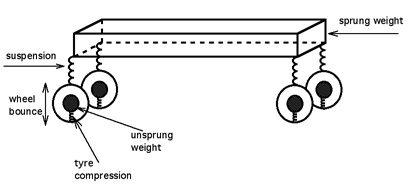Unsprung mass
Appearance
This article needs additional citations for verification. (May 2007) |

In a ground vehicle with a suspension, the unsprung weight (or, more properly, the unsprung mass) is the mass of the suspension, wheels or tracks (as applicable), and other components directly connected to them, rather than supported by the suspension. (The mass of the body and other components supported by the suspension is the sprung mass.) Unsprung weight includes the mass of components such as the wheel spindles, wheel bearings, tires, and a portion of the weight of driveshafts, springs, shock absorbers, and suspension links. If the vehicle's brakes are mounted outboard (i.e., within the wheel), their weight is also part of the unsprung weight.
